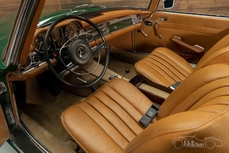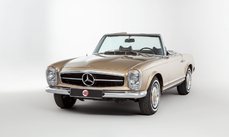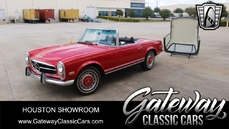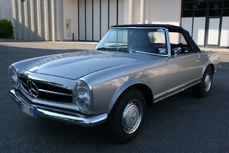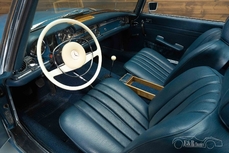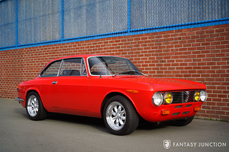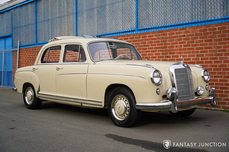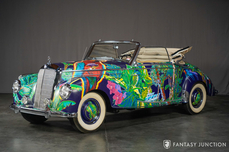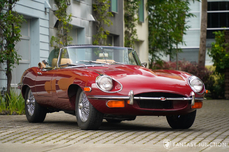Mercedes-Benz 280SL w113 2.8 Liter Inline-6 1969
General description :
1969 Mercedes-Benz 280SL
s/n 113044-10-004981
Red with Cognac Interior
With more than a century of superb automotive engineering and refined craftsmanship, Mercedes-Benz continues to remain one of the premier automobile innovators, delivering vehicles of optimum performance and premier luxury year after year. During the 1950s, decades of racing achievement and luxury refinement matured dramatically while US market growth encouraged new models, further endearing the brand to new and dedicated customers.
The mid 60s proved to be a rapidly changing time for sports cars. The budding 230SL was slated to replace both the 190SL and the iconic 300SL – an ominous task given the 300SL was a performance powerhouse, while the 190 was nearly the opposite. The 230SL delivered perfectly, instantly delighting customers seeking a charming, yet balanced sporty car with clean styling, captivating details, and spirited performance. The clarity and simplicity of design continued under the hood with technical advancements including Bosch fuel-injection, overhead-cam six cylinder engine, and syncromesh transmission, all of which delivered proven Mercedes-Benz performance. A convertible top, and substantial trunk space allowed for elegant presence and practical traveling, even over long distances. Among the many features offered in the car, several innovative safety aspects were incorporated into the unique body design including being the first sports car with a rigid passenger cell and designated crumple zones, industry standard today, but thoroughly new for a sports car in 1963.
This lovely 1969 280SL is a structurally excellent example of this iconic series Mercedes-Benz. The most notable being the 2.8L engine delivering 170hp, mated to a 4-speed manual transmission. The car was delivered new to California where it has been registered and owned for the past 48 years. The current owner purchased it from a local California resident having owned the car for approximately 20 years, with very limited miles accumulated in the past five years. Currently showing what are understood to be 134,000 original miles, the car features power steering, manual transmission, seats redone in leather, and comes with both hard and soft tops.
Today the car presents as a very nice combination of an original and partially restored example of a very straight and dry, strong running 280SL. The paint is in very nice condition overall with high gloss and quality finishing in all areas. The paint was applied to the original body panels with care to all inner surfaces, edges, corners, and trim, tending nicely to areas under the hood while thoughtfully retaining the original hood insulation pad, which remains in beautiful condition today. Critically important on these cars are the original fenders and hood, specifically evidenced by the factory spot welds revealed in these inner areas. Here, the original front fenders and the area inside the grille under the hood show their correct factory spot-welds. Further validating the original front fenders, the inside front fender ridges or fin tips (often sanded over when cars have been repaired) are evident and crisp on both sides.
The doors shut very well, retaining very good panel gaps and crisp latching. The hood and trunk also exhibit nice fit and closure with consistent gaps. The chrome throughout is in very good condition, with nice luster and clean, bright reflections, though some areas show light hazing, typical of original chrome. All lenses, lighting, and glass are in very good condition with only minor evidence of road use on the windshield and minor aging to the unique clear headlight enclosures and plastic surrounds. The new black canvas convertible top has been handsomely tailored with a clear and taut rear window, tight top bow wrapping, and very nice fabric welting on the underside of the canvas. The car comes with the distinctive “Pagoda Roof” hardtop, which is painted red to match the exterior. Outfitted with correct narrow white wall tires and stainless steel wheel covers, the stance and ride height very nicely convey elegance and performance.
The interior, is a nice combination of original Mercedes-Benz Tex (MB-Tex) finishes and recently recovered leather seats. The leather used on the seats is of high quality and matches very nicely with the car. The dash is nicely preserved with very clean instruments and recently redone wood trim, surrounded by the MB-Tex material, which is in very nice preserved condition. Of particular note is the matching red insert inside the dash, contrasting the black instruments and touches of lacquered wood trim. The interior door panels, armrests, and various trim are all in very good condition, while the darker carpeting has wear in the driver’s footwell. The dashboard has very nicely preserved instruments, and a modern Kenwood stereo. With the canvas top folded into storage position, the hard shell cover latches confidently, creating a handsome profile with the red exterior and tan interior surrounding the cabin.
The engine compartment is nicely detailed and properly presented with correct parts, correct power steering, fuel-injection, factory components, with attention to hard lines, hoses, and electrical as needed. There is no engine number stamping or riveted plate on the block, likely indicating a factory replacement block during previous ownership. The fuel injection plenum is clean and nicely detailed echoing much of the originality and care exhibited while preserving this fine 280SL. The paint on the inside of the engine compartment appears to be original, is smooth, and very nicely finished, preserving the original cowl insulation. The trunk is clean and nicely finished with original satin black underside, inner trunk surround and factory tire pressure sticker, finished with a correct floor mat, and proper spare tire cover.
The car starts easily and idles smoothly, having been thoughtfully used throughout ownership, but in the past five years accumulating only minimal miles. Driving manners are as expected for a nice original example with a smooth manual gearbox and responsive clutch pedal. The ride engineering, disc brakes, and responsive suspension create composed power delivery for two occupants, with plenty of luggage space for refined touring. The floor pan, trunk floor, and undercarriage are both solid and straight, showing no evidence of structural compromise, merely typical road use. The car is offered with a set of factory owner’s books and tools and the hardtop.
This is a wonderful opportunity to acquire a driver ready 280SL. Finished in great colors, ready for enjoyable driving, touring with a friend, or overnight adventures. With a few suitcases safely stored and the top down, this 280SL will eagerly delight its fortunate occupants into the open road adventures and joys that only a classic Mercedes-Benz can elegantly deliver.
http://fantasyjunction.com/cars/2147-Mercedes-Benz-280SL-2.8%20Liter%20Inline-6
1969 Mercedes-Benz 280SL w113 2.8 Liter Inline-6 is listed sold on ClassicDigest in Emeryville by Fantasy Junction for $74500.
Car Facts
Car type : Car Make : Mercedes-Benz Model : 280SL w113 Model Version : 2.8 Liter Inline-6 Engine size : 2.8 Model Year : 1969 Sub type : Convertible Location : Emeryville
Sold
Seller Information
Sold
People who viewed this Mercedes-Benz 280SL w113 also viewed similar Mercedes-Benz listed at ClassicDigest
Other cars listed for sale by this dealer
About Mercedes-Benz
In the annals of automotive history, the journey of Mercedes-Benz is a tale that unfolds with the ingenuity of its founding pioneers. In the year 1886, Karl Benz crafted the Benz Patent Motorwagen, a creation that would go down in history as the world's inaugural automobile. Unbeknownst to him, this moment marked the genesis of what would evolve into the most illustrious premium car manufacturer globally. The financial underpinning of this pioneering venture, interestingly, was provided by Karl Benz's wife, Bertha Benz, demonstrating a remarkable partnership that would set the tone for Mercedes-Benz's legacy.A parallel narrative emerged not far away, as Daimler-Motoren-Gesellschaft, founded by Gottlieb Daimler and Wilhelm Maybach, entered the scene. In 1901, they unveiled their automobile under the now-famous moniker "Mercedes," meaning "godsend" in Spanish. This name was bestowed upon the car at the behest of Emil Jellinek's daughter, the distributor for Daimler-Motoren-Gesellschaft. The wheels of innovation were set in motion.
Fast forward to 1926, a pivotal year that witnessed the merger of Daimler with Benz & Cie., culminating in the birth of Daimler-Benz. The amalgamation saw the adoption of "Mercedes-Benz" as the distinguished trademark for their automobiles, fusing the legacies of two visionary entities into one.
Contrary to perceptions of conservatism, the trajectory of Daimler-Benz unfolds as a chronicle of industry firsts. From the introduction of the honeycomb radiator to the float carburetor, and the pioneering implementation of four-wheel brakes in 1924, Daimler-Benz consistently pushed the boundaries of automotive innovation. The diesel-powered Mercedes-Benz 260 D in 1936 marked the inception of diesel engines in passenger cars. The iconic Mercedes-Benz 300SL Gullwing made history as the first car with direct fuel injection, albeit the Gutbrod's tiny 2-stroke engine can claim precedence.
Safety innovations became a hallmark, with Béla Barényi's patented safety cell design in the "Ponton"-models in 1951, featuring front and rear crumple zones. The W116 450SEL 6.9 saw the introduction of the Anti-Lock Brake system (ABS), another pioneering safety feature. From the first production airbags and beyond, the legacy of "firsts" continued to be etched into the fabric of Daimler-Benz.
Over its centennial journey, Mercedes-Benz has not merely produced cars but has sculpted automotive icons. The SSKL, 710 SSK Trossi Roadster, 770K Grosser, 540K Spezial Roadster, 300SL Gullwing, w100 600 Pullman, w111 280SE 3.5 Flachkühler, w113 230SL Pagoda, w109 300 SEL 6.3, and w201 2.3-16 Cosworth stand testament to the brand's commitment to engineering excellence.
The roaring Silver Arrows, or "Silberpfeile," including the W 25, W 125, W154, W165, and W196, created a legacy of dominance on the racetrack. These machines were not merely cars; they were expressions of precision, speed, and an indomitable spirit that left their competitors in the dust.
As Mercedes-Benz marches into the future, it does so not just as an automaker but as a custodian of a legacy, a torchbearer of innovation, and a beacon of automotive excellence. The road ahead is sure to witness the continued fusion of cutting-edge technology, timeless design, and an unwavering commitment to setting new standards in the world of automobiles.
One luminary figure who left an indelible mark was Béla Barényi, often heralded as the "father of passive safety" for his pioneering work in safety engineering. His patented safety cell design, featuring front and rear crumple zones, became a hallmark of Mercedes-Benz's commitment to occupant safety, setting new standards that reverberated throughout the automotive world.
Moving through the chronicles, the collaborative genius of Wilhelm Maybach, alongside Gottlieb Daimler, laid the foundation for Daimler-Motoren-Gesellschaft. Their innovations not only birthed the first Mercedes but established a culture of relentless pursuit of technological excellence that remains integral to Mercedes-Benz's DNA.
In the post-merger era of 1926, Ferdinand Porsche emerged as a prominent figure within Mercedes-Benz. His work on the Mercedes-Benz S-Type, a supercharged race car, garnered acclaim and set the stage for a legacy that extended far beyond the marque. Porsche's impact would later extend to his eponymous company, but his influence at Mercedes-Benz during those formative years was pivotal.
As the 20th century progressed, the legendary Rudolf Uhlenhaut emerged as a key figure. Uhlenhaut, an accomplished engineer and the driving force behind the iconic Silver Arrows, played a crucial role in Mercedes-Benz's dominance in motorsports. His engineering prowess and attention to detail were instrumental in creating some of the most formidable racing cars of the era.
In the latter half of the century, figures like Bruno Sacco, the head of design at Mercedes-Benz from 1975 to 1999, left an indelible imprint on the brand's aesthetic identity. Sacco's design philosophy, characterized by clean lines and timeless elegance, shaped iconic models like the W126 S-Class and the W201 190E, solidifying Mercedes-Benz's reputation for luxury and sophistication.
The narrative would be incomplete without acknowledging the contributions of engineers like Hans Scherenberg, whose leadership in the 1970s ushered in a new era of technological innovation at Mercedes-Benz. Scherenberg's tenure saw the development of groundbreaking technologies, including the Anti-Lock Brake system (ABS) and the introduction of airbags in production cars.


